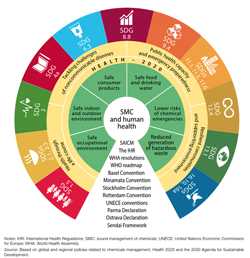Data and statistics

Hazardous chemicals, whether naturally occurring or man-made, can reach the human body through different routes (such as food, air and water) and cause a variety of health effects.
Chemicals and children
Children are more vulnerable to the effects of exposure to chemicals, and cannot protect their rights to live in a safe environment. Globally, 54% of the burden of disease attributable to environmental exposures, expressed in disability-adjusted life-years (DALYs), is borne by children under the age of 15 years. Children are exposed to chemicals every day and throughout their lives. There is growing recognition of the long-lasting effects of exposure to toxic environmental agents in early life, which can lead to diseases later in life; in the case of exposure to certain chemicals at critical life stages, impacts can even manifest themselves across generations.
Occupational exposure to chemicals
Occupational exposures, exposure to lead and acute poisonings resulting from unsound management are estimated to account globally for 1 303 100 million deaths (2.3% of total) and 43 109 000 DALYs (1.6% of total). Health effects considered include poisoning, leukaemia, lung cancer, ischaemic heart disease, stroke, intellectual disability and chronic obstructive pulmonary diseases.
Health impacts from hazardous chemicals (asbestos, endocrine-disrupting chemicals, lead, mercury)
Worldwide, the use of asbestos has declined by 55% from its historical peak of 4.7 million metric tonnes per year in 1980, but more than 2 million metric tonnes per year are still used. WHO estimates that 107 000 annual deaths globally are caused by mesothelioma, asbestos-related lung cancer and asbestosis. In 2005 occupational exposure to asbestos was estimated to cause 43 000 mesothelioma deaths and 7000 deaths due to asbestosis worldwide. Of those caused by mesothelioma, 7000 in the WHO European Region. In total, Europe registered 106 180 asbestos-related disease deaths, accounting for 60% of the global burden. Europe also had higher age-adjusted mortality rates for mesothelioma (7.8 versus 5.2 deaths/million population/year) and asbestosis (1.0 versus 0.8 deaths/million population/year) than the worldwide average.
Lead affects many systems and organs, in particular the nervous system; it is especially dangerous for children since it can damage their neurodevelopmental abilities. Lead in paints is a meaningful source of exposure for children. Currently, eight of the 46 Member States in the WHO European Region for which data are available (17.4%) do not have legally binding lead controls in place.
Mercury is well known neurotoxicant with severe effects on the developing brain. According to the latest survey, within the European Union more than 200 000 children born every year are exposed to methylmercury above the safety limit of 2.5 μg/g (in hair) recommended by WHO. In Europe mercury pollution exacts a toll of €5.1 billion/year.
Endocrine-disrupting chemicals realize their effects, either alone or in mixtures, during fetal and postnatal life and have a strong and often irreversible effect on developing organs. Scientific evidence confirms links between exposure to endocrine-disrupting chemicals and reproductive, metabolic and neurological and neurodevelopmental disorders, diabetes and hormone-related cancers. In the WHO European Region a recent analysis estimated the costs of the burden of disease attributable to endocrine-disrupting chemicals at €163 billion per year.
Acute poisonings
Acute poisonings still cause mortality in the WHO European Region. An average mortality rate from unintentional poisonings in the Region is 0.27 deaths per 100 000 population.
A poisons centre is a specialized unit that advises on and assists with the prevention, diagnosis and management of poisoning. Such centres are not established in 17 of the 53 Member States in the WHO European Region (32%). The structure and function varies around the world; however, at a minimum a poisons centre is an information service. Some poisons centres include clinical, toxicological and chemical units.



